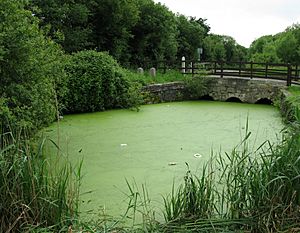Titchfield Canal facts for kids
The Titchfield Canal is a special waterway in Hampshire, England. It is about two miles long. It runs between the village of Titchfield and the coast at Titchfield Haven. This area is now a nature reserve. The canal runs next to the River Meon. But it is clearly man-made, not a natural river. People have debated why it was built.
Contents
What Was the Canal For?
People have suggested three main reasons why the Titchfield Canal was built:
- It might have been a channel for boats. This idea came from the 3rd Earl of Southampton.
- It might have been built to supply water to special fields called water meadows.
- It might have been built for both reasons.
Watering Fields
It is certain that the canal was used to water fields. These fields are called water meadows. You can still see the patterns of these meadows from the path along the canal. They are even clearer if you look at satellite images.
You can also still see parts of the gates that let water from the canal into the meadows. These gates are called sluices. Old maps from the 1800s show many more of these sluices. This shows the canal was definitely used for farming.
When Was It Built?
It is not clear exactly when the Titchfield Canal was built. We also do not know for sure who built it. And we do not know if it was ever used for boats.
The Haven's Closure
On June 24, 1611, a church record book noted something important. It said that "Titchfield Haven was shut out" by someone named Richard Talbot. This was done for the Earl of Southampton. People have thought this meant a wall or bank, called a dike, was built. This dike would have blocked the Meon Estuary. It would stop boats from reaching Titchfield from the sea.
There is a dike across the Estuary today. But we do not know exactly what was built in 1611. Some people thought the canal was built at the same time. They believed it was a new way for boats to travel. But so far, no old documents from that time prove this idea. The few documents we have suggest it was a project to create new land from the water. This kind of project would not always need to completely close the estuary.
Later Work and Court Cases
More big construction work happened in the Meon Estuary in the 1670s. In a court case from 1739, older people gave their statements. They said that boats used to sail up to Titchfield when they were young. They said this stopped when the Earl's family built a barrier across the river. They were not exact about the date. But their statements suggest the final closure happened around the 1670s.
Also, records from the Titchfield local court in 1676 show something interesting. They say the Lord of the Manor built the New River. By doing this, he "took away" parts of land rented by two tenants. This suggests the New River was built recently around that time.
What We Think Now
The old documents we have, along with what we can see today, point to one main idea. It seems the canal was built more for farming than for boats. But we need to find more evidence to be completely sure.
A book mentioned below has many papers about these ideas. It also has many references to original sources.


